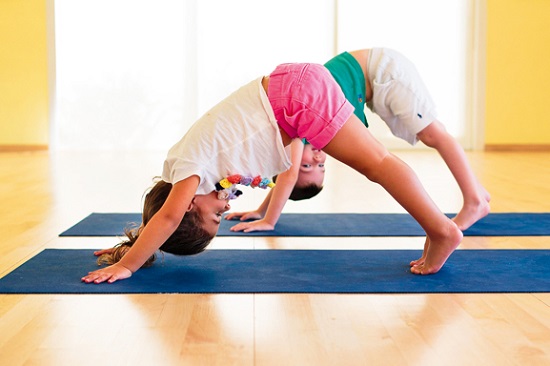Many people are involved in practicing some form of yoga. Health benefits come in the form of improved muscle tone, stress reduction, improved flexibility, and more. Children, even babies under a year old, can begin to learn yoga and benefit from its practice in man of the ways adults benefit.
Yoga’s roots come from India over 5,000 years ago. The word “yoga” comes from Sanskrit and it is translated as “union,” or “to yoke”. Its purpose is to bring well-being on physical, mental, emotion and spiritual levels.
Beyond all the health benefits, what makes yoga a unique form of exercise is that it’s available to everyone regardless of age, fitness level, and health status. It can be practiced by children, teens, adults, and seniors. People who need healing from various medical conditions such as anxiety, depression, arthritis, scoliosis, low back pain and more can also benefit from the low impact exercises.
Young children enjoy imitating yoga poses. Their bodies are very flexible and because they have less bone weight than adults, they are often able to old poses as well as adults. Some yoga poses imitate positions a baby’s body naturally assumes. Other poses are named after animals, nature, or actions which many young children are familiar with. Children’s yoga classes often include chanting, signing, and making funny animal noises corresponding with the pose.
Yoga helps kids participating in high-level sports build core strength. Yoga doesn’t target just one muscle group or body area. It stretches, exercises, and strengthens the entire body. Athletes benefit from the total body muscle strengthening and relaxation techniques for overall improved health and fitness.
For teens, yoga can also help ease anxiety and stress. Yoga can ease the anxiety and stress common to teens by bringing forth calmness, confidence, coolness and improved relationships with friends and family. Better breathing can help improve focus and may help kids improve the ability to study. Better breathing allows the brain to receive more oxygen. A well oxygenated brain produces efficient thinking. Reduced anxiety and tension can help kids do better on tests, too. A stronger physical body, better posture, and improved balance can help teens through some of the awkward times with improved confidence and poise.
Yoga is also constructive for children with special needs. Yoga allows children with motor skills disorders, as well as children with musculoskeletal conditions, to improve their breathing patterns, which are often restricted by tight muscles in the chest wall. It helps “overexcited” muscles to quiet down and lengthen, improving child’s flexibility. For children on the Autistic spectrum, yoga helps to calm their bodies and minds. It can help focus on a desired adult generated topic rather than a child centered fixation. With practice, yoga can allow an ASD child to perform an activity with better accuracy and for longer periods of time. Better performance toward an adult generated goal can improve a child’s self-confidence and self-worth.
Yoga improves a child’s quality of sleep. A stronger body with improved breathing patterns and a better oxygenated brain will sleep more deeply and regularly. A well-rested child will have a more even temperament which can help keep a home calmer and allow parents time to organize the home and thoughts, rest, and provide an overall higher quality of parenting.
Practicing yoga as a family helps develop family or spiritual bonds. A family that participated together in an activity shares an experience that can be discussed on many levels. Feelings and facts can be shared in relation to the benefits of the experience, drawing parties into a common core of bonding.















